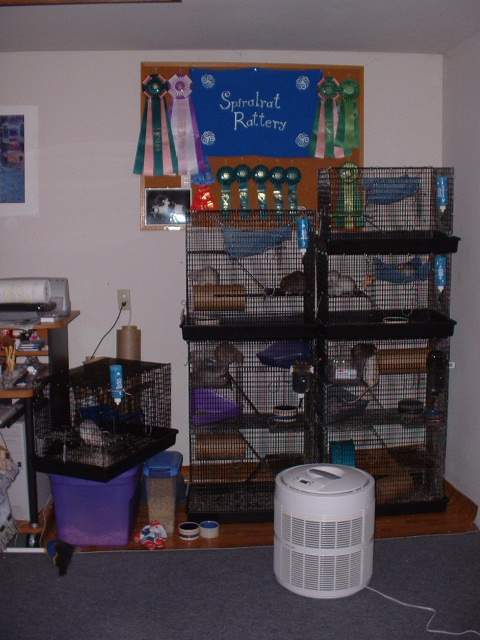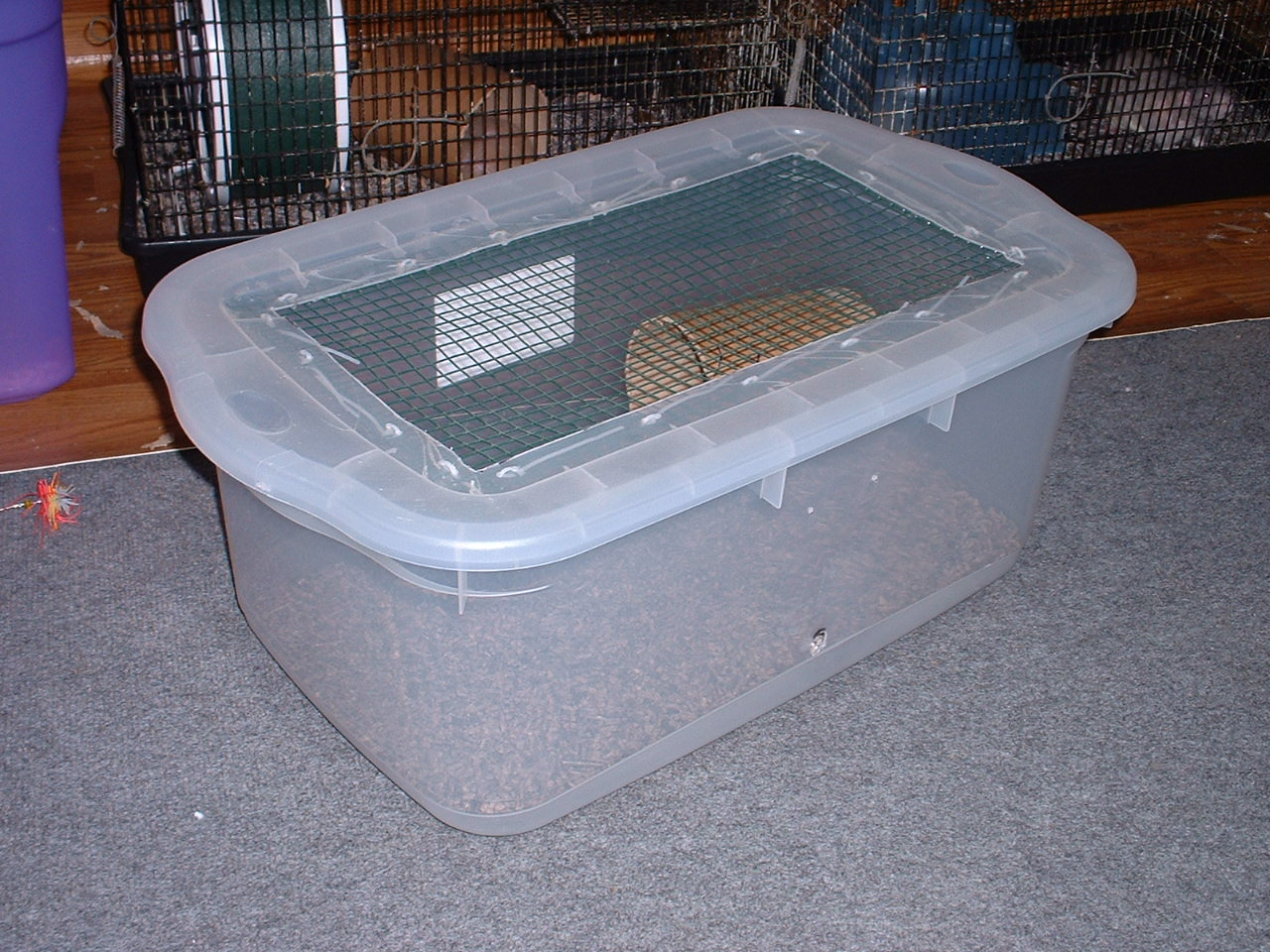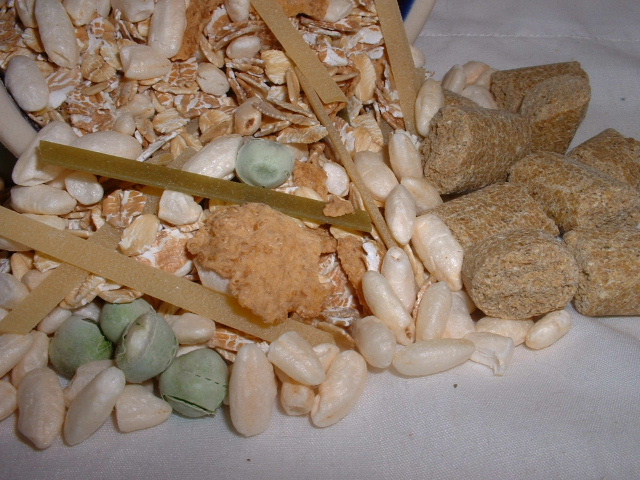|
|
 |
|
Housing and Bedding
I only house my rats in Martins Cages, they are spacious and easy to clean. I currently have two R-690s for adult females, one R-680 for adult
males, and three R-660s for mating/maternity cages. I keep upto 6 adult females and 4 adult males per R-690 and 3 adult
males fit nicely in my one R-680. I also have a HEPA filter which helps to cut down on the dust which aggravates
my allergies.

For shows and traveling I have plastic sterilite containers,
which I have modified with hardware cloth for ventilation.

My bedding of choice is Yesterday's News pelleted paper cat
litter. It is relatively inexpensive for the number of cages I have, and has excellent moisture and odor absorbing properties.
For pinkies and younger rats I will use shaved Aspen bedding, as it has a softer texture.
Cage furniture and enrichment items that I use include: plastic shoeboxes as nest boxes; corner
Hi-Back litter trays as litterboxes or hang-out spots; heavy-duty cardboard shipping tubes cut down and wired to the sides
of the cages; solid plastic SuperPet wheels in the active females' cages; and old jean legs hung up as hammocks for my
sedentary boys. My girls can shred a hammock in about a day and my boys are too lazy to use a wheel, so I don't
bother providing them with them.

I'm a stickler for sanitation, so I like to use items in my
cages that can be easily washed and bleached or are cheap enough that I can just toss them. Consequently I only use
plastic items. The cardboard shipping tubes I get free from work and the jeans I buy at thrift stores, so it's not a
big cost to toss them when they get dirty.

Health Care and Veterinary Attention
Every time I clean cages I give my rats a mini health exam.
I'll feel for any lumps or bumps, check the fur and skin for scratches or signs of lice, examine eyes and nose for any signs
of discharge, listen to their lungs and breathing, and check their overall fleshiness for proper body weight. I also
keep a first aid kit handy. Some items I include are: Panalog or Bacitracin for skin wounds, Terramycin for the eyes,
Hibiclens to clean scratches and sanitize my own hands, a selection of small syringes to flush wounds and dispense
meds, Advantage for lice outbreaks, and antibiotics...I'm fortunate that my vet will usually give me extras when
I bring one of my crew in.
For veterinary attention the fine doctors at Alder Trail Animal Hospital in Bremerton Washington
provide my crew with excellent care. Dr's Yiek and Neuman are very knowledgable about rodents. They are located
in East Bremerton Washington, and can be contacted at (360) 377-3971.

|
 |
|
Diet and Feeding
I feed my rats a homemade grain mix based on SueBee's Recipe and Mazuri rodent blocks which I purchase from LeAnn at Rattie Rascals. My version of the grain mix is detailed on the right, and I can find all the ingredients at my
local Fred Meyer store in the bulk foods and health food sections. I mix everything up in a rubbermaid container, and
the proportions listed last my crew of 15 approximately 3 weeks.


Since rats are more active a night, I feed them once a day in the evening....a full bowl of grain
mix and 2 to 3 lab blocks per rat in the cage. I've got it down so I put just enough grain mix in each cage and
there are few leftovers the following night. The evening is also when I refill water bottles.
My rats get treats on a fairly regular basis. Nothing goes to waste in my house, all human leftovers
end up in the rat cages. Thanksgiving and Christmas is their favorite time of year, as they get turkey bones with meat
left on them. Other treats include: whole nuts, raw or cooked veggies, Old Mother Hubbard Just Veggin' dog biscuits,
bread crusts with a little olive oil spread on them, and whatever else they can con out of me. If I'm in a cooking mood
I'll make them a special recipe consisting of lightly boiled veggie pasta and a can of low-salt mixed veggies drained
and mixed together with olive oil. Olive oil has many health benefits for rats, and is especially good for their coats.
I try to avoid sugary things for them, including dried fruits and Yoggies. The Total cereal
in the grain mix has sugar in it, but it's vitamin content balances it...so I try to elimate other sources of sugar from
their diet.
Some foods to avoid: raw beans or peanuts, orange juice for males, carbonated sodas, and bleu cheese.
A full listing can be found on the Rat Fan Club diet page, scroll down to the bottom.
|
 |
|
|
|
 |
|
My Rat Grain Mix
Recipe
|
 |
 |
|
- 4 lbs thick rolled oatmeal
- 2 lbs rolled
barley
- 2 lbs rolled triticale
- 1 lb veggie pasta
-
1/4 lb raw sunflower seeds (shelled)
- 3.5 oz freeze dried veggies (usually
peas)
- 1/2 small box of Total cereal (or 1/3 of a big box)
- 1
bag puffed rice cereal
- 1/2 lb unsalted roasted soynuts (if I can find them, in place of the sunflower seeds)
|
|
|



